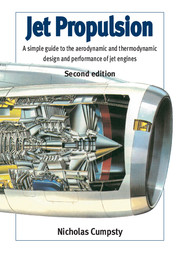 Jet Propulsion
Jet Propulsion Book contents
- Frontmatter
- Contents
- Preface
- Glossary
- Nomenclature
- Part 1 Design of Engines for a New 600-seat Aircraft
- Part 2 Engine Component Characteristics and Engine Matching
- Part 3 Design of Engines for a New Fighter Aircraft
- 13 A New Fighter Aircraft
- 14 Lift, Drag and the Effects of Manoeuvring
- 15 Engines for Combat Aircraft
- 16 Design Point for a Combat Engine
- 17 Combat Engines Off-design
- 18 Turbomachinery for Combat Engines
- Part 4 Return to the Civil Transport Engine
- Appendix: Noise and its Regulation
- Bibliography
- References
- Index
- Design sheets for New Large Civil Aircraft and New Fighter Aircraft
13 - A New Fighter Aircraft
from Part 3 - Design of Engines for a New Fighter Aircraft
- Frontmatter
- Contents
- Preface
- Glossary
- Nomenclature
- Part 1 Design of Engines for a New 600-seat Aircraft
- Part 2 Engine Component Characteristics and Engine Matching
- Part 3 Design of Engines for a New Fighter Aircraft
- 13 A New Fighter Aircraft
- 14 Lift, Drag and the Effects of Manoeuvring
- 15 Engines for Combat Aircraft
- 16 Design Point for a Combat Engine
- 17 Combat Engines Off-design
- 18 Turbomachinery for Combat Engines
- Part 4 Return to the Civil Transport Engine
- Appendix: Noise and its Regulation
- Bibliography
- References
- Index
- Design sheets for New Large Civil Aircraft and New Fighter Aircraft
Summary
INTRODUCTION
This part of the book begins the consideration of the engine requirements of a new fighter aircraft. In parallel with the treatment in earlier chapters for the engines of the new large civil aircraft, the approach chosen is to address the design of engines for a possible new aircraft so that the text and exercises can be numerically based with realistic values. The specifications for the New Fighter Aircraft used here have a marked similarity to those available for the new Eurofighter.
The topic of the present chapter is the nature of the combat missions and the type of aircraft involved. Figure 13.1 shows the different regions in which aircraft operate in terms of altitude versus Mach number, with the lines of constant inlet stagnation temperature overlaid. We are concerned here with what are referred to in the figure as fighters, a major class of combat aircraft. Figure 13.1 shows the various boundaries for normal operation. Even high-speed planes do not normally fly at more than M = 1.2 at sea level because in the high density air the structural loads on the aircraft and the physiological effects on the crew become too large. At high altitude high-speed aircraft do not normally exceed M ≈ 2.3, largely because the very high stagnation temperatures preclude the use of aluminium alloys without cooling.
- Type
- Chapter
- Information
- Jet PropulsionA Simple Guide to the Aerodynamic and Thermodynamic Design and Performance of Jet Engines, pp. 179 - 188Publisher: Cambridge University PressPrint publication year: 2003


